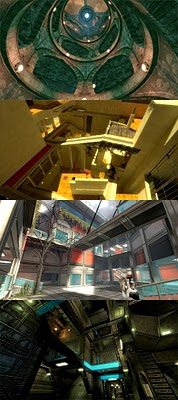Kneejerk commentators from RPS: I'm not saying people don't make mods anymore. Of course people still make mods, but these are very different mods from traditional ideas of the blockbuster TC mod.
This was the subject of
a roundtable podcast I did with other modders (moderated by the fresh-smelling Phillip Marlowe) but I thought I'd write some stuff I couldn't articulate when barely awake at unearthly hours of the morning. In this post I also speak generally of modding in the contexts I know it (Starcraft, Half-Life 1, Source Engine) instead of just limiting it to Source modding.
Okay, so: Before, there wasn't really anything. So, we modded.
Then there were just a few random 3D engines (Ogre3D, Cube, etc.) but no widespread adoption because they were difficult to use. Want a level editor? Code it yourself!... So, we modded. Besides, only mods got publicity on fan sites anyway; our work was worthless, inferior to the professionals. Who would ever pay for it?
Unmarketable. We were just fans and amateurs, working with the permission of the big boys.
There was no indie RTS, no indie FPS. So we just modded Starcraft. We made tower defense maps or
Aeon of Strife maps (the 1999 precursor to DOTA). We also modded Half-Life and made this little thing called Counter-Strike. Modding has changed the face of the game industry, but we only know that in hindsight.
Now, everything has changed.
There are new, powerful standalone 3D game creation packages (Unity, UDK) with integrated engines and toolsets that have physics, IK solvers, heightmap terrain editors, etc. Our "amateur" work can be sold on Steam, the App Store, the Android Market, or even by ourselves. Popular blogs readily publicize / discuss these "indie" efforts. In general, it seems amateurs are just more disciplined and more skilled with the practice of game development.
There's now an indie RTS genre, it's called tower defense. There's an indie FPS, it's called Minecraft and has been a huge paradigm shift in itself. A huge, "indie" culture has reconfigured how we see video games: masocore, QWOP, Spelunky, the cult of personality behind Cactus, the Copenhagen Games Collective, anything touched by Stephen Lavelle, Tale of Tales, and so much more.
These are great reconfigurers.
Meanwhile, the only recent, equivalent, reconfiguring event in the mod community that comes to my mind is Dear Esther.
In this sense, "modding," as we know it, is dead... Because we aren't merely fans or amateurs anymore. We're now "indie," we're somewhat independent of the commercial game industry that spawned modding: we now have a shared culture, publicity engine and distribution mechanisms that happily exists outside of them.
Which is great.
There will still be many mods, of course,
but they are definitely no longer the center of innovative design practice by non-professionals. Black Mesa Source will likely be the last "total conversion" mod ever completed, in the face of the rising (time) cost of development and the accessibility of good standalone options. Great games like "The Dark Mod" will no longer be constrained by an audience that doesn't have Doom 3.
As for the future, here are my predictions:
Unity is going to get bigger. Once
they release their Flash deployment, assuming it's for free, they'll finally surmount that last "download the plug-in" hurdle and millions of bored office workers will flock to the platform. Flashbang Studios' "Blurst" initiative stimulated one era of Unity; the Flash tech will stimulate another.
Much like "gamer," the term "indie" will apply to so many people that it loses meaning. I'm on
Anna Anthropy's boat in pushing a populist approach to game development: tools will get easier, distribution more robust, and
one day everyone will just make games for everyone.
Also: start looking around. DotA and tower defense started in 1999, and now ten years later they're distinct, billion dollar genres. What's lingering in the shadows right now?
What grows from the charred corpse of modding?
A forest.







